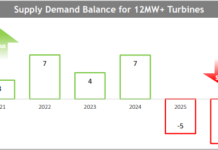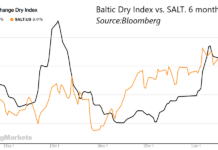Tom Konrad CFA
Canadian weather data shows the variability-smoothing potential of a robust continental electric grid.
Intelligent skepticism is valuable to me as an investor when it makes me question my assumptions. When I’m wrong, it makes me find out sooner (and hopefully get out of a bad trade sooner, or never get into it.) When I’m right, I emerge with my thesis tested, which leads to the confidence needed to stick to a trade when the stock market voting machine moves against me in the short term, before it comes around in the longer term.
Over the last month or so, John Petersen and I have been going back and forth regarding the potential to smooth wind power output. Most recently, he latched onto a study and some graphs from the Bonneville Power Association which he felt demonstrated that geographical dispersion does not work. He wrote, “I am unwilling to assume that integration across multiple regions will do the trick without seeing a compilation and overlay of the hard data from those regions and a plan that lays out how the interconnections will work.”
Methodology
Actual wind output data is usually kept private by wind farm operators and utilities, so instead I turned to publicly accessible wind speed data. I found data in usable form from Canada’s Weather Office. I then selected four widely dispersed Canadian weather stations which had hourly historical data available, and copied the wind speed data into a spreadsheet for the week of April 1st to 7th, 2011. In selecting weather stations, I chose one each in British Colombia, Yukon Territory, Newfoundland, and Nunavut that seemed to have enough wind to be suitable locations for wind farms.
 I then converted these wind speeds into simulated power output using a wind power curve, shown here. This takes the wind speed data, and replaces it with the likely power output (expressed as a percentage of rated output) for a wind turbine. Wind turbines don’t produce any power at very low wind speeds, ramp up quickly to their full rated power output as wind speed increases, and cut off suddenly to protect themselves in extremely high winds.
I then converted these wind speeds into simulated power output using a wind power curve, shown here. This takes the wind speed data, and replaces it with the likely power output (expressed as a percentage of rated output) for a wind turbine. Wind turbines don’t produce any power at very low wind speeds, ramp up quickly to their full rated power output as wind speed increases, and cut off suddenly to protect themselves in extremely high winds.
Over the week selected, the simulated wind output from my four weather stations was basically uncorrelated between the widely dispersed sites, as you can see from the following correlation matrix:
| Correlation | Dease Lake (AUT) British Columbia | Argentia (AUT) New- foundland |
MAYO A (Yukon) | Cambridge Bay A Nunavut | Wind 4 Sites | ERCOT North | ERCOT 2010 | |
|
1 | -0.05 | -0.03 | -0.19 | 0.35 | 0 | 0.02 | |
| Argentia (AUT) New- foundland |
1 | -0.06 | -0.15 | 0.53 | -0.04 | -0.09 | ||
| MAYO A (Yukon) | 1 | 0.10 | 0.49 | 0.07 | -0.10 | |||
|
1 | 0.40 | 0.01 | -0.12 | ||||
| Wind 4 sites | 1 | 0.01 | -0.16 | |||||
| ERCOT North | 1 | 0.74 | ||||||
| ERCOT 2010 | 1 |
The “All 4 sites” column represents the sum of the simulated output from the four sites, while the ERCOT North and ERCOT 2010 columns contain demand statistics for the Texas grid for the same week in 2010 (I did not know where to find 2011 data.) ERCOT North is one of eight Texas sub-regions. I’m using ERCOT data for load simply because that was the load data I found most readily available.
Note that the correlation between “All 4 sites” and each individual wind site is approximately 50% in each case. This is what we would expect if the wind sites were truly independent and uncorrelated.
ERCOT North is similarly highly correlated with ERCOT because not only is it is part of the larger region, but because the distances involved are smaller and because electric loads tend to be much more highly correlated across regions than weather patterns.
Diversification
The low correlation in wind output is key because when low or uncorrelated variables are added, the deviation of the average of all the variables is lower than the deviation of the individual variables. The calculations are simplest for uncorrelated variables, but diversification has some use whenever variables are not perfectly correlated.
In the case of n uncorrelated variables with the same standard deviation s, the standard deviation of the average of all n is s / sqrt(n). Since I am using 4 basically uncorrelated sites in this example, the standard deviation of the average of all four sites is approximately half the standard deviation of each of the individual sites, as shown in the blue bars of the following chart and table.

| BC | Newfoundland | Yukon | Nunavut | Wind 4 Sites | ERCOT North | ERCOT (2010) load | |
|---|---|---|---|---|---|---|---|
| Std Dev | 36% | 48% | 35% | 39% | 19% | 11.4% | 11.1% |
| min | 0% | 0% | 0% | 0% | 7% | 55% | 59% |
| max | 100% | 100% | 100% | 100% | 100% | 100% | 100% |
| avg | 35% | 41% | 40% | 60% | 48% | 80% | 79% |
| Percent = 0 | 30% | 55% | 27% | 19% | 0% | 0% | 0% |
Not Baseload
A quick glance at the following chart showing wind output from the four sites demonstrates that while there may be some value to diversification, we’re not talking about anything like baseload power here. It’s not necessary for wind to produce baseload power in order to be effectively integrated into the grid. Aggregate wind power needs only to be reasonably predictable and not so volatile that utility systems cannot keep up. After all, utilities have been coping with variations of demand, which is neither entirely predictable, nor flat.

The following chart compares the output from the average volatility simulated wind site (Cambridge Bay, in British Columbia) with the output from an average of all four sites, and ERCOT load data from Texas.

Here it is clear to see that the average wind output (blue line) is much less volatile than the wildly swinging green line. If we wanted to reduce average wind output volatility to the same level as we see in the ERCOT North demand curve, it would require 12 uncorrelated wind sites [39.5% / sqrt(12) = 11.4%], or a larger number of partially correlated sites. Given my experience with the data so far, I think it would not be difficult to find a sufficient number of partially correlated sites within Canada, and the exercise would be simple if the area were expanded to cover both the US and Canada.
Such a large grid would have the added benefit of smoothing the volatility of demand. We see this on a small scale when comparing the volatility of the ERCOT North sub-region to ERCOT as a whole, but, as with weather, correlation in demand curves will fall with distance due to different working habits, industries, weather conditions, and time zones.
Lower volatility in overall demand compared to local demand would free up dispatchable resources to help compensate for the remaining volatility of wind output.
In the Real World
In theory, we can reduce the volatility of wind output to less than the volatility of demand by building a North American continental grid. In practice, such a grid is unlikely to be built anytime soon. But we do not need a continental grid to achieve many of the benefits of diversification. Shorter connections, especially when chosen to maximize differences in weather patterns can be of great benefit in smoothing wind output and demand.
Complete lack of correlation is not necessary to reduce overall volatility, although there would be benefits in not only siting new wind farms to maximize power output, but to also consider the correlation of local winds to the output of other wind farms and local electric demand. Such steps could do much to reduce the strain that the variability of wind puts on the electric grid, and in the end allow greater wind penetration.
The addition of solar resources can also greatly reduce the overall variability, given that solar output is somewhat correlated with demand and not particularly correlated with wind. The output of solar sites tends to be much more correlated with that of other solar sites than for wind, but solar sites are not completely correlated, since output varies with cloudiness, latitude, orientation, temperature, and solar technology.
The fact that summer electric loads tend to peak in the evening just as the sun is setting can also be alleviated with transmission and planning. The output of West- and North-west facing panels is more correlated with load, and, even without storage available from technologies such as Concentrating Solar Power, traditional PV panels in the desert Southwest are producing power long after the
sun has set in New York.
Conclusions for Investors
Wind farms are currently overly clustered in areas with good wind and access to transmission. As a result, we see graphs of actual wind output that are much more variable than the technology need be inherently.
While electricity storage is effective for smoothing short term volatility in electric supply and loads, long distance transmission, especially High Voltage DC transmission is the most cost-effective technology for smoothing long-term variations. Prospective wind investors should also be considering companies involved in building, maintaining, and supplying transmission, especially leading HVDC suppliers Siemens (SI) and ABB (ABB).
Calculations and Data
For those interested in my data and methodology, I have uploaded the spreadsheet I used for my calculations to Google Docs in both native Open Office Calc and MS Excel formats.
DISCLOSURE: No Positions.
Past performance is not a guarantee or a reliable indicator of future results. This article contains the current opinions of the author and such opinions are subject to change without notice. This article has been distributed for informational purposes only. Forecasts, estimates, and certain information contained herein should not be considered as investment advice or a recommendation of any particular security, strategy or investment product. Information contained herein has been obtained from sources believed to be reliable, but not guaranteed.








Simple math. Generation on the grid must be more than load.
Wind generators do not produce when it is too hot, too cold, too windy or not enough wind.
Excellent work Tom.
Simple Ed: peak generation capacity in any developed country is much higher than peak load. Germany’s peak load is around 70 GWp, whereas its generation capacity lies at 140 GW:
http://www.eia.doe.gov/cfapps/ipdbproject/IEDIndex3.cfm?tid=2&pid=2&aid=7
We have a mix of generation sources today, we’ll have a mix in the future. No big deal.
We actually did similar study for solar divestment of risk..to be presented at the IEEE power tech 2011 conference in Trondheim Norway this June. If interested email me o get a preprint.
It still looks terribly variable to me and as I noted in our earlier e-mail correspondence I tend to believe that proving a lack of correlation is not enough. The whole theory of geographic dispersal is that the wind will be blowing hard enough at points B and C to offset weak wind conditions at point A. The only way I know to prove that point is to take statistically valid samples from each location, put them all together in a monster spreadsheet, turn the crank and see what comes out.
I’m a great respecter of proprietary data but if a wind energy advocate wants me to support the widespread deployment of wind, he damned sure better be ready to give me enough hard data to double check his representations that geographic dispersion will significantly mitigate variability.
Since I won’t buy a marketable security without doing my homework and testing management’s representations, I sure won’t spend my money (or yours) on an illiquid investment where the due diligence information is triple secret.
John,
Yes, it still looks very variable. As I said in the article, we’d need to 12 sites to reduce the volatility to approximately the same level as load.
I agree that until I come up with 12 such sites, I won’t have “proven” anything, but given that the methodology I was using was cutting and pasting data from a website, I chose to stop at four.
My goal is not to convince you (John) to buy wind stocks, my goal is to show that the arguments you put forth in your article are not supported by the evidence.
I have shown that widely dispersed sites do reduce volatility. I have not shown (although I believe) that wind output volatility can be reduced to less than the level of the volatility of load using only sites in North America.
My results agree with the available literature (Such as Sandeep’s paper) and with basic mathematical principles. At this point I feel the burden of proof lies with the skeptics.
Because I already believe my result, I don’t feel the need to spend the necessary hours cutting and pasting wind speed data into a spreadsheet. But I have provided my spreadsheet for anyone who does feel that this is a good use of their time.